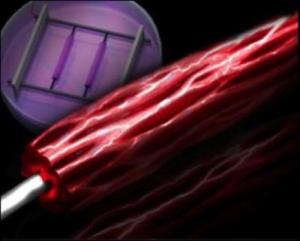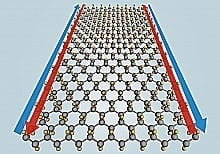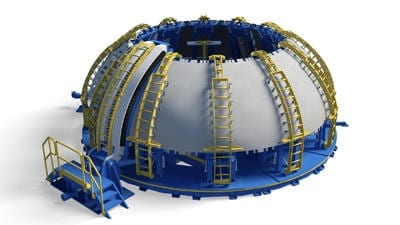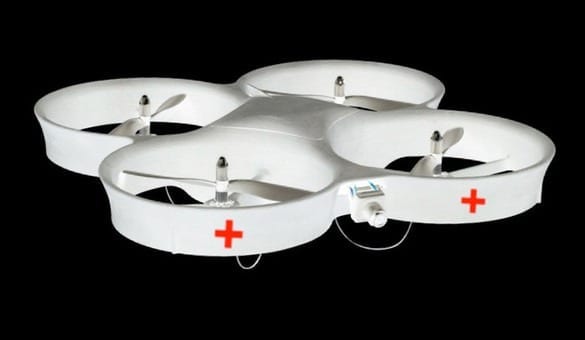
A new method of maturing human heart cells that simulates the natural growth environment of heart cells while applying electrical pulses to mimic the heart rate of fetal humans has led researchers at the University of Toronto to an electrifying step forward for cardiac research.
The discovery, announced this week in the scientific journal Nature Methods, offers cardiac researchers a fast and reliable method of creating mature human cardiac patches in a range of sizes.
“You cannot obtain human cardiomyocytes (heart cells) from human patients,” explains Milica Radisic, Canada Research Chair in Functional Cardiovascular Tissue Engineering and Associate Professor at the Institute of Biomaterials & Biomedical Engineering (IBBME) and the Department of Chemical Engineering. Because human heart cells — integral for studying the efficacy of cardiac drugs, for instance — do not naturally proliferate in large numbers, to date researchers have been using heart cells derived from reprogrammed human induced pluripotent stem cells (hiPSC’s), which tend to be too immature to use effectively in research or transplantation.
“The question is: if you want to test drugs or treat adult patients, do you want to use cells and look like and function like fetal cardiomyocytes?” asks Radisic, who was named a “Top Innovator Under 35” by MIT Technology Review and more recently was awarded the Order of Ontario and the Young Engineers of Canada 2012 Achievement Award. “Can we mature these cells to become more like adult cells?”
In response to the challenge, Radisic and her team, which includes graduate student Jason Miklas and Dr. Sara Nunes, a scientist at the University Health Network (UHN) in Toronto, created a ‘biowire’. Stem-cells derived human cardiomyocytes are seeded along a silk suture typical to medical applications. The suture allows the cells to grow along its length, close to their natural growth pattern.
Like a scene lifted from Frankenstein, the cells are then treated to cycles of electric pulses, like a mild version of a pacemaker, which have been show to stimulate the cells to increase in size, connect and beat like a real heart tissue.
But the key to successfully and rapidly maturing the cells turns out to be the way the pulses are applied.
Mimicking the conditions that occur naturally in cardiac biological development — in essence, simulating the way fetal heart rates escalates prior to birth, the team ramped up the rate at which the cells were being stimulated, from zero to 180 and 360 beats per minute.
“We found that pushing the cells to their limits over the course of a week derived the best effect,” reports Radisic.
Grown on sutures that can be sewn directly into a patient, the biowires are designed to be fully transplantable. The use of biodegradable sutures, important in surgical patches that will remain in the body, is also a viable option.
Miklas argues that the research has practical implications for health care. “With this discovery we can reduce costs on the health care system by creating more accurate drug screening.”
The Latest Bing News on:
Biowire
- Feed has no items.
The Latest Google Headlines on:
Biowire
[google_news title=”” keyword=”Biowire” num_posts=”10″ blurb_length=”0″ show_thumb=”left”]
The Latest Bing News on:
Human cardiac patches
- These 6 Iowa high school graduates made advocacy and volunteering their missionon May 9, 2024 at 3:44 am
Six students, including zoo volunteers, a church leader and LGBTQ+ advocates, were nominated in recognition of their advocacy and volunteer work.
- Breaking Down Artivion: 4 Analysts Share Their Viewson May 7, 2024 at 5:26 am
The 12-month price targets, analyzed by analysts, offer insights with an average target of $25.5, a high estimate of $30.00, and a low estimate of $22.00. Marking an increase of 10.87%, the current ...
- His Christmas Miracleon May 5, 2024 at 9:36 pm
Ghosts of Christmases Past His thoughts, as he stood on this jutting crag in Sunrise Gap, were with a recent 'experience meeting' at which he had sought to canvass his spiritual needs. His demand of a ...
- Columbia students are sick at heart — just as we were in ‘68on May 1, 2024 at 10:50 am
An organizer of the 1968 Columbia University protests on why the message against war, then and now, is the same.
- A genetic patch corrects a rare syndrome in human brain organoid grafted into a raton April 24, 2024 at 9:51 am
The team led by Sergiu Pasca, from Stanford University, wants to test this promising strategy in children with Timothy Syndrome, which is associated with autism and epilepsy ...
- Opening up the potential of thin-film electronics for flexible chip designon April 23, 2024 at 5:00 pm
Foundry business model At the heart of the worldwide ... less than a human hair. That makes it ideal for, for example, medical applications like wearable patches. Such ultra-thin wearables can ...
- A Novel Patch for Heart Rhythm Monitoringon April 6, 2024 at 5:00 pm
as well as handheld heart rhythm recording devices, both to be used for symptomatic episodes only. Use of the Zio ® Patch in an Ambulatory Setting The Zio ® Patch (iRhythm Technologies ...
- Heart-muscle Patches Created from Human Cells Improve Recovery from Heart Attackson November 4, 2023 at 7:55 pm
Large, human cardiac-muscle patches created in the lab have been tested, for the first time, on large animals in a heart attack model. This clinically relevant approach showed that the patches ...
- A Novel Patch for Heart Rhythm Monitoringon June 30, 2022 at 11:59 pm
There is no public information as to why the Heart Check device was approved by the US FDA for direct sale to individuals, yet the AliveCor and Zio Patch products require prescription by a US ...
The Latest Google Headlines on:
Human cardiac patches
[google_news title=”” keyword=”human cardiac patches” num_posts=”10″ blurb_length=”0″ show_thumb=”left”]











